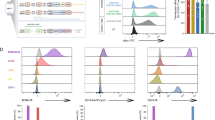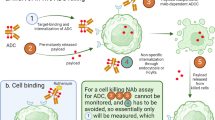Abstract
Neuroblastoma (NBL) accounts for a disproportionate number of deaths among childhood malignancies despite intensive multimodal therapy that includes antibody targeting disialoganglioside GD2, a NBL antigen. Unfortunately, resistance to anti-GD2 immunotherapy is frequent and we aimed to investigate mechanisms of resistance in NBL. GD2 expression was quantified by flow cytometry and anti-GD2 antibody internalization was measured using real-time microscopy in 20 human NBL cell lines. Neutrophil-mediated antibody-dependent cellular cytotoxicity (ADCC) assays were performed on a subset of the cell lines (n = 12), and results were correlated with GD2 expression and antibody internalization. GD2 was expressed on 19 of 20 NBL cell lines at variable levels, and neutrophil-mediated ADCC was observed only in GD2-expressing cell lines. We found no correlation between level of GD2 expression and sensitivity to neutrophil-mediated ADCC, suggesting that GD2 expression of many cell lines was above a threshold required for maximal ADCC, such that expression level could not be used to predict subsequent cytotoxicity. Instead, anti-GD2 antibody internalization, a process that occurred universally but differentially across GD2-expressing NBL cell lines, was inversely correlated with ADCC. Treatment with endocytosis inhibitors EIPA, chlorpromazine, MBCD, and cytochalasin-D showed potential to inhibit antibody internalization; however, only MBCD resulted in significantly increased sensitivity to neutrophil-mediated ADCC in 4 of 4 cell lines in vitro. Our data suggest that antibody internalization may represent a novel mechanism of immunotherapy escape by NBL and provide proof-of-principle that targeting pathways involved in antibody internalization may improve the efficacy of anti-GD2 immunotherapies.





Similar content being viewed by others
References
Pinto NR, Applebaum MA, Volchenboum SL et al (2015) Advances in risk classification and treatment strategies for neuroblastoma. J Clin Oncol Off J Am Soc Clin Oncol 33:3008–3017. https://doi.org/10.1200/jco.2014.59.4648
Cheung NK, Cheung IY, Kushner BH, Ostrovnaya I, Chamberlain E, Kramer K, Modak S (2012) Murine anti-GD2 monoclonal antibody 3F8 combined with granulocyte-macrophage colony-stimulating factor and 13-cis-retinoic acid in high-risk patients with stage 4 neuroblastoma in first remission. J Clin Oncol Off J Am Soc Clin Oncol 30:3264–3270. https://doi.org/10.1200/jco.2011.41.3807
Ladenstein R, Pötschger U, Valteau-Couanet D et al (2018) Interleukin 2 with anti-GD2 antibody ch14.18/CHO (dinutuximab beta) in patients with high-risk neuroblastoma (HR-NBL1/SIOPEN): a multicentre, randomised, phase 3 trial. Lancet Oncol 19:1617–1629. https://doi.org/10.1016/s1470-2045(18)30578-3
Yu AL, Gilman AL, Ozkaynak MF et al (2010) Anti-GD2 antibody with GM-CSF, interleukin-2, and isotretinoin for neuroblastoma. N Engl J Med 363:1324–1334. https://doi.org/10.1056/NEJMoa0911123
Federico SM, McCarville MB, Shulkin BL et al (2017) A pilot trial of humanized Anti-GD2 monoclonal antibody (hu14.18K322A) with chemotherapy and natural killer cells in children with recurrent/refractory neuroblastoma. Clin Cancer Res Off J Am Assoc Cancer Res 23:6441–6449. https://doi.org/10.1158/1078-0432.Ccr-17-0379
Mody R, Naranjo A, Van Ryn C et al (2016) Phase II randomized trial of irinotecan/temozolomide (I/T) with temsirolimus (TEM) or dinutuximab plus granulocyte colony stimulating factor (DIN/GMCSF) in children with refractory or relapsed neuroblastoma: A report from the Children’s Oncology Group (COG). J Clin Oncol 34:2. https://doi.org/10.1200/JCO.2016.34.15_suppl.10502
Mody R, Yu AL, Naranjo A et al. (2020) Irinotecan, Temozolomide, and Dinutuximab With GM-CSF in Children With Refractory or Relapsed Neuroblastoma: A Report From the Children's Oncology Group. Journal of clinical oncology : official journal of the American Society of Clinical Oncology. https://doi.org/10.1200/jco.20.00203
Schumacher-Kuckelkorn R, Volland R, Gradehandt A, Hero B, Simon T, Berthold F (2017) Lack of immunocytological GD2 expression on neuroblastoma cells in bone marrow at diagnosis, during treatment, and at recurrence. Pediatr Blood Cancer 64:46–56. https://doi.org/10.1002/pbc.26184
Batova A, Kamps A, Gillies SD, Reisfeld RA, Yu AL (1999) The Ch14.18-GM-CSF fusion protein is effective at mediating antibody-dependent cellular cytotoxicity and complement-dependent cytotoxicity in vitro. Clin Cancer Res Off J Am Assoc Cancer Res 5:4259–4263
Chen RL, Reynolds CP, Seeger RC (2000) Neutrophils are cytotoxic and growth-inhibiting for neuroblastoma cells with an anti-GD2 antibody but, without cytotoxicity, can be growth-stimulating. Cancer Immunol Immunother CII 48:603–612
Zeng Y, Fest S, Kunert R, Katinger H, Pistoia V, Michon J, Lewis G, Ladenstein R, Lode HN (2005) Anti-neuroblastoma effect of ch14.18 antibody produced in CHO cells is mediated by NK-cells in mice. Mol Immunol 42:1311–1319. https://doi.org/10.1016/j.molimm.2004.12.018
Thomas VA, Balthasar JP (2019) Understanding inter-individual variability in monoclonal antibody disposition. Antibodies (Basel, Switzerland). https://doi.org/10.3390/antib8040056
Beers SA, French RR, Chan HT et al (2010) Antigenic modulation limits the efficacy of anti-CD20 antibodies: implications for antibody selection. Blood 115:5191–5201. https://doi.org/10.1182/blood-2010-01-263533
Lim SH, Vaughan AT, Ashton-Key M et al (2011) Fc gamma receptor IIb on target B cells promotes rituximab internalization and reduces clinical efficacy. Blood 118:2530–2540. https://doi.org/10.1182/blood-2011-01-330357
Rudnick SI, Lou J, Shaller CC, Tang Y, Klein-Szanto AJ, Weiner LM, Marks JD, Adams GP (2011) Influence of affinity and antigen internalization on the uptake and penetration of Anti-HER2 antibodies in solid tumors. Cancer Res 71:2250–2259. https://doi.org/10.1158/0008-5472.Can-10-2277
Reddy V, Cambridge G, Isenberg DA, Glennie MJ, Cragg MS, Leandro M (2015) Internalization of rituximab and the efficiency of B Cell depletion in rheumatoid arthritis and systemic lupus erythematosus. Arthritis & rheumatology (Hoboken, N.J.). 67: 2046–55. doi: https://doi.org/10.1002/art.39167
Fewou SN, Rupp A, Nickolay LE, Carrick K, Greenshields KN, Pediani J, Plomp JJ, Willison HJ (2012) Anti-ganglioside antibody internalization attenuates motor nerve terminal injury in a mouse model of acute motor axonal neuropathy. J Clin Investig 122:1037–1051. https://doi.org/10.1172/jci59110
Keshelava N, Seeger RC, Groshen S, Reynolds CP (1998) Drug resistance patterns of human neuroblastoma cell lines derived from patients at different phases of therapy. Cancer Res 58:5396–5405
Keshelava N, Zuo JJ, Chen P, Waidyaratne SN, Luna MC, Gomer CJ, Triche TJ, Reynolds CP (2001) Loss of p53 function confers high-level multidrug resistance in neuroblastoma cell lines. Cancer Res 61:6185–6193
Keshelava N, Frgala T, Krejsa J, Kalous O, Reynolds CP (2005) DIMSCAN: a microcomputer fluorescence-based cytotoxicity assay for preclinical testing of combination chemotherapy. Methods Mol Med 110:139–153. https://doi.org/10.1385/1-59259-869-2:139
Dutta D, Donaldson JG (2012) Search for inhibitors of endocytosis: intended specificity and unintended consequences. Cell Logist 2:203–208. https://doi.org/10.4161/cl.23967
Siebert N, Troschke-Meurer S, Marx M et al. (2018) Impact of HACA on Immunomodulation and Treatment Toxicity Following ch14.18/CHO Long-Term Infusion with Interleukin-2: Results from a SIOPEN Phase 2 Trial. Cancers. 10. doi: https://doi.org/10.3390/cancers10100387
Metelitsa LS, Gillies SD, Super M, Shimada H, Reynolds CP, Seeger RC (2002) Antidisialoganglioside/granulocyte macrophage-colony-stimulating factor fusion protein facilitates neutrophil antibody-dependent cellular cytotoxicity and depends on FcgammaRII (CD32) and Mac-1 (CD11b/CD18) for enhanced effector cell adhesion and azurophil granule exocytosis. Blood 99:4166–4173. https://doi.org/10.1182/blood.v99.11.4166
Siebert N, Jensen C, Troschke-Meurer S, Zumpe M, Juttner M, Ehlert K, Kietz S, Muller I, Lode HN (2016) Neuroblastoma patients with high-affinity FCGR2A, -3A and stimulatory KIR 2DS2 treated by long-term infusion of anti-GD2 antibody ch14.18/CHO show higher ADCC levels and improved event-free survival. Oncoimmunology. 5: e1235108. doi: https://doi.org/10.1080/2162402x.2016.1235108
Wang W, Erbe AK, Hank JA, Morris ZS, Sondel PM (2015) NK cell-mediated antibody-dependent cellular cytotoxicity in cancer immunotherapy. Front Immunol 6:368. https://doi.org/10.3389/fimmu.2015.00368
Fehling-Kaschek M, Peckys DB, Kaschek D, Timmer J, Jonge N (2019) Mathematical modeling of drug-induced receptor internalization in the HER2-positive SKBR3 breast cancer cell-line. Sci Rep 9:12709. https://doi.org/10.1038/s41598-019-49019-x
Wargalla UC, Reisfeld RA (1989) Rate of internalization of an immunotoxin correlates with cytotoxic activity against human tumor cells. Proc Natl Acad Sci USA 86:5146–5150. https://doi.org/10.1073/pnas.86.13.5146
Ackerman ME, Pawlowski D, Wittrup KD (2008) Effect of antigen turnover rate and expression level on antibody penetration into tumor spheroids. Mol Cancer Ther 7:2233–2240. https://doi.org/10.1158/1535-7163.Mct-08-0067
Crimeen-Irwin B, Ellis S, Christiansen D, Ludford-Menting MJ, Milland J, Lanteri M, Loveland BE, Gerlier D, Russell SM (2003) Ligand binding determines whether CD46 is internalized by clathrin-coated pits or macropinocytosis. J Biol Chem 278:46927–46937. https://doi.org/10.1074/jbc.M308261200
Diaz FE, Dantas E, Cabrera M et al (2016) Fever-range hyperthermia improves the anti-apoptotic effect induced by low pH on human neutrophils promoting a proangiogenic profile. Cell Death Dis. https://doi.org/10.1038/cddis.2016.337
Delieu JM, Badawoud M, Williams MA, Horobin RW, Duguid JK (2001) Antipsychotic drugs result in the formation of immature neutrophil leucocytes in schizophrenic patients. J Psychopharmacol 15:191–194. https://doi.org/10.1177/026988110101500306
Delieu JM, Horobin RW, Duguid JK (2009) Exploring the relationship of drug-induced neutrophil immaturity & haematological toxicity to drug chemistry using quantitative structure-activity models. Med Chem 5:7–14. https://doi.org/10.2174/157340609787049307
Creed TM, Tandon S, Ward RA, McLeish KR (2017) Endocytosis is required for exocytosis and priming of respiratory burst activity in human neutrophils. Inflamm Res 66:891–899. https://doi.org/10.1007/s00011-017-1070-2
Dinutuximab, Sargramostim, and Combination Chemotherapy in Treating Patients With Newly Diagnosed High-Risk Neuroblastoma Undergoing Stem Cell Transplant. https://ClinicalTrials.gov/show/NCT03786783
Dinutuximab and Irinotecan Versus Irinotecan to Treat Subjects With Relapsed or Refractory Small Cell Lung Cancer. https://ClinicalTrials.gov/show/NCT03098030
Dinutuximab in Combination With Sargramostim in Treating Patients With Recurrent Osteosarcoma. https://ClinicalTrials.gov/show/NCT02484443.
Dobrenkov K, Ostrovnaya I, Gu J, Cheung IY, Cheung NK (2016) Oncotargets GD2 and GD3 are highly expressed in sarcomas of children, adolescents, and young adults. Pediatr Blood Cancer 63:1780–1785. https://doi.org/10.1002/pbc.26097
Acknowledgements
The authors would like to acknowledge Drs. Yves DeClerck, Nora Heisterkamp, and Chintan Parekh for manuscript review, and Drs. John Li and Alan Wayne for their valuable input.
Funding
This work was supported, in part, by a T32 CA009659 training grant (RT) from the National Cancer Institute (PI Y.A. DeClerck) and by the V Foundation (SA); and in part by the CA170257P1 from the Department of Defense (SA), P01 CA217959 National Cancer Institute (co-I SA, PI R.C. Seeger, J Maris), T.J. Martell Foundation, and Nautica Malibu Triathlon (SA).
Author information
Authors and Affiliations
Contributions
RT and SA conceived and designed the study. RT, KKY, SM, ML performed the research and also analyzed the data. SM, CJ, TP, and MS contributed reagents and analysis tools. The manuscript was written by RT, SA, and MS. All authors edited and approved the submission of this manuscript.
Corresponding author
Ethics declarations
Conflict of interest
The authors declare that they have no conflict of interest.
Ethical approval
This article does not contain any studies with human participants or animals performed by any of the authors.
Additional information
Publisher's Note
Springer Nature remains neutral with regard to jurisdictional claims in published maps and institutional affiliations.
Supplementary Information
Below is the link to the electronic supplementary material.
Rights and permissions
About this article
Cite this article
Tibbetts, R., Yeo, K.K., Muthugounder, S. et al. Anti-disialoganglioside antibody internalization by neuroblastoma cells as a mechanism of immunotherapy resistance. Cancer Immunol Immunother 71, 153–164 (2022). https://doi.org/10.1007/s00262-021-02963-y
Received:
Accepted:
Published:
Issue Date:
DOI: https://doi.org/10.1007/s00262-021-02963-y




